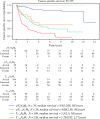Should Patients with Renal Cell Carcinoma and Pathological Nodal Invasion Be Classified As Having Stage IV Disease?
- PMID: 37291441
- PMCID: PMC10319662
- DOI: 10.1245/s10434-022-12979-y
Should Patients with Renal Cell Carcinoma and Pathological Nodal Invasion Be Classified As Having Stage IV Disease?
Abstract
Background: Lymph node invasion is associated with poor outcome in patients with renal cell carcinoma (RCC).
Patients and methods: Patients with RCC within a single center from 2001 to 2018 were retrospectively obtained from the Chang Gung Research Database. Patient gender, physical status, Charlson Comorbidity Index, tumor side, histology, age at diagnosis, and body mass index (BMI) were compared. The overall survival (OS) and cancer-specific survival (CSS) of each group were estimated using the Kaplan-Meier method. Log-rank tests were used to compare between the subgroups.
Results and conclusions: A total of 335 patients were enrolled, of whom 76 had pT3N0M0, 29 had pT1-3N1M0, 104 had T1-4N0M1, and 126 had T1-4N1M1 disease. Significant OS difference was noted between pT3N0M0 and pT1-3N1M0 groups with 12.08 years [95% confidence interval (CI), 8.33-15.84] versus 2.58 years (95% CI, 1.32-3.85), respectively (P < 0.005). No significant difference was observed in OS between pT1-3N1M0 and T1-4N0M1 groups with 2.58 years (95% CI, 1.32-3.85) versus 2.50 years (95% CI, 1.85-3.15, P = 0.72). The OS of N1M1 group was worse than that of N0M1 group with 1.00 year (95% CI, 0.74-1.26) versus 2.50 years (95% CI, 1.85-3.15, P < 0.05). Similar results were also observed in CSS. In summary, we claim that RCC with lymph node (LN) invasion should be reclassified as stage IV disease in terms of survival outcome.
© 2023. The Author(s).
Conflict of interest statement
The authors have no conflict of interest to disclose.
Figures
References
-
- AJCC Cancer Staging Manual | Mahul B. Amin | Springer. Accessed July 15, 2019. https://www.springer.com/gp/book/9783319406176
-
- European temporal trends in the use of lymph node dissection in patients with renal cancer—ScienceDirect. Accessed June 28, 2021. https://www.sciencedirect.com/science/article/pii/S0748798317306005 - PubMed
MeSH terms
Grants and funding
LinkOut - more resources
Full Text Sources
Medical
Research Materials




